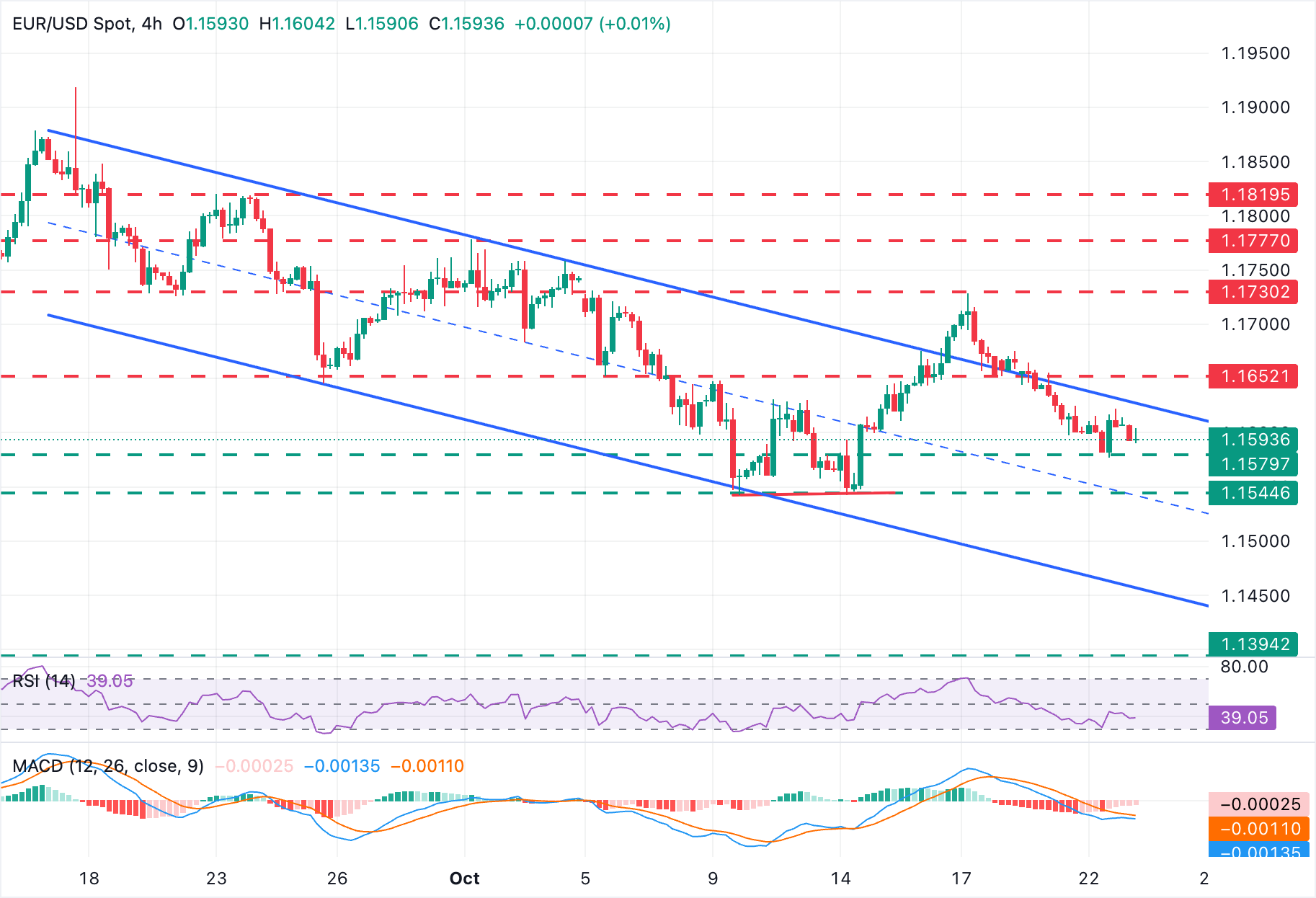Created
: 2025.10.23














![]() 2025.10.23 16:38
2025.10.23 16:38
EUR/USD drifts lower at the European session opening on Thursday, trading right below 1.1600 at the time of writing, down from the previous day's highs at 1.1620. Fresh trade frictions between the US and China are supporting the safe-haven US Dollar, yet with market volatility subdued as traders brace for the US Consumer Price Index (CPI) data, due on Friday.
In the absence of key macroeconomic data releases, as the US government shutdown continues, trade frictions remain one of the most significant market drivers. In that sense, news that the US is considering curbs on software-related exports to China has revived the trade rift between the world's two major economies.
The impact on markets, however, has been moderate, as investors are still confident that a meeting between US President Donald Trump and his Chinese counterpart Xi Jinping will lead to an extension of the trade truce, avoiding these threats from materializing.
In Thursday's economic calendar, the speech of European Central Bank (ECB) committee member Philip Lane and the release of the Eurozone's Consumer Confidence index will attract attention. In the US, the Chicago and Kansas Federal Reserve (Fed) National Activity Indexes and speeches by Fed governors Michelle Bowman and Michael Barr will provide the fundamental guidance for USD crosses.
The table below shows the percentage change of Euro (EUR) against listed major currencies today. Euro was the strongest against the Japanese Yen.
| USD | EUR | GBP | JPY | CAD | AUD | NZD | CHF | |
|---|---|---|---|---|---|---|---|---|
| USD | 0.07% | 0.07% | 0.27% | -0.01% | -0.07% | 0.05% | 0.13% | |
| EUR | -0.07% | 0.00% | 0.21% | -0.08% | -0.13% | -0.02% | 0.06% | |
| GBP | -0.07% | -0.00% | 0.18% | -0.07% | -0.13% | -0.02% | 0.06% | |
| JPY | -0.27% | -0.21% | -0.18% | -0.29% | -0.32% | -0.24% | -0.13% | |
| CAD | 0.00% | 0.08% | 0.07% | 0.29% | -0.04% | 0.06% | 0.13% | |
| AUD | 0.07% | 0.13% | 0.13% | 0.32% | 0.04% | 0.11% | 0.21% | |
| NZD | -0.05% | 0.02% | 0.02% | 0.24% | -0.06% | -0.11% | 0.08% | |
| CHF | -0.13% | -0.06% | -0.06% | 0.13% | -0.13% | -0.21% | -0.08% |
The heat map shows percentage changes of major currencies against each other. The base currency is picked from the left column, while the quote currency is picked from the top row. For example, if you pick the Euro from the left column and move along the horizontal line to the US Dollar, the percentage change displayed in the box will represent EUR (base)/USD (quote).

EUR/USD maintains its bearish trend intact, with upside attempts finding sellers. The pair was capped at 1.1620 and is now hovering above support at Wednesday's low near 1.1580. The Relative Strength Index (RSI) remains below the 50 area, highlighting negative momentum, and the Moving Average Convergence Divergence (MACD) remains below the signal line.
Below 1.1580, the October 9 and 14 lows in the area of 1.1545 will come into focus. Further down, the channel bottom, now around 1.1455, emerges as the next potential target. To the upside, Wednesday's high, at 1.1620 and the top of the descending channel, around 1.1625, are likely to challenge bulls ahead of the October 21 high, around 1.1650, and the October 17 high, at 1.1728.
Generally speaking, a trade war is an economic conflict between two or more countries due to extreme protectionism on one end. It implies the creation of trade barriers, such as tariffs, which result in counter-barriers, escalating import costs, and hence the cost of living.
An economic conflict between the United States (US) and China began early in 2018, when President Donald Trump set trade barriers on China, claiming unfair commercial practices and intellectual property theft from the Asian giant. China took retaliatory action, imposing tariffs on multiple US goods, such as automobiles and soybeans. Tensions escalated until the two countries signed the US-China Phase One trade deal in January 2020. The agreement required structural reforms and other changes to China's economic and trade regime and pretended to restore stability and trust between the two nations. However, the Coronavirus pandemic took the focus out of the conflict. Yet, it is worth mentioning that President Joe Biden, who took office after Trump, kept tariffs in place and even added some additional levies.
The return of Donald Trump to the White House as the 47th US President has sparked a fresh wave of tensions between the two countries. During the 2024 election campaign, Trump pledged to impose 60% tariffs on China once he returned to office, which he did on January 20, 2025. With Trump back, the US-China trade war is meant to resume where it was left, with tit-for-tat policies affecting the global economic landscape amid disruptions in global supply chains, resulting in a reduction in spending, particularly investment, and directly feeding into the Consumer Price Index inflation.
![]()
Created
: 2025.10.23
![]()
Last updated
: 2025.10.23

FXStreet is a forex information website, delivering market analysis and news articles 24/7.
It features a number of articles contributed by well-known analysts, in addition to the ones by its editorial team.
Founded in 2000 by Francesc Riverola, a Spanish economist, it has grown to become a world-renowned information website.
We hope you find this article useful. Any comments or suggestions will be greatly appreciated.
We are also looking for writers with extensive experience in forex and crypto to join us.
please contact us at [email protected].
Disclaimer:
All information and content provided on this website is provided for informational purposes only and is not intended to solicit any investment. Although all efforts are made in order to ensure that the information is correct, no guarantee is provided for the accuracy of any content on this website. Any decision made shall be the responsibility of the investor and Myforex does not take any responsibility whatsoever regarding the use of any information provided herein.
The content provided on this website belongs to Myforex and, where stated, the relevant licensors. All rights are reserved by Myforex and the relevant licensors, and no content of this website, whether in full or in part, shall be copied or displayed elsewhere without the explicit written permission of the relevant copyright holder. If you wish to use any part of the content provided on this website, please ensure that you contact Myforex.
Myforex uses cookies to improve the convenience and functionality of this website. This website may include cookies not only by us but also by third parties (advertisers, log analysts, etc.) for the purpose of tracking the activities of users. Cookie policy